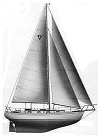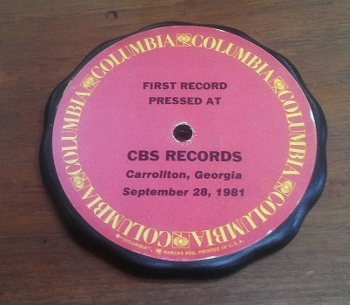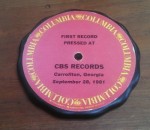

Pressing Details – CBS Records
 My best early tour of the CBS Records plant was conducted by my friend Brad Pirch. He took me into every department and described what the engineering issues were in each place, how the process used to work and what was currently being done to improve. He conveyed the same attitude as the Engineers from HQ: the plant is a wonderland of problems waiting to be solved. They shaved off minutes and pennies, which led to the high productivity and lower labor required in each successive plant. Brad had both scope and detail in his explanations. I begged Brad for memories about his 40 years as an engineer with CBS Records and he responded brilliantly. Enjoy!
My best early tour of the CBS Records plant was conducted by my friend Brad Pirch. He took me into every department and described what the engineering issues were in each place, how the process used to work and what was currently being done to improve. He conveyed the same attitude as the Engineers from HQ: the plant is a wonderland of problems waiting to be solved. They shaved off minutes and pennies, which led to the high productivity and lower labor required in each successive plant. Brad had both scope and detail in his explanations. I begged Brad for memories about his 40 years as an engineer with CBS Records and he responded brilliantly. Enjoy!
The remaining ingredients in the record compound were waxes, stabilizers, and anti-oxidants. Every one had to be totally compatible with the main vinyl mixture in order for the surface of the record to be SAABA – Smooth As A Baby’s Ass – another bonafide quality term used in the process. The vinyl compound was very unstable at elevated temperatures, too. There is a small temperature/time window between getting the compound soft enough to mold accurately to the groove configuration, and when the compound begins to decompose. Besides causing some of those noise terms, the decomposing of pvc created hydrochloric acid in vapor form – which was murder on the equipment to say nothing of the damage to the coworkers respiratory systems. The smell of the press room was acrid and often brought tears to my eyes, unless the bigshots were coming for a visit. Then it smelled like wet paint.
I was trying to remember how many presses we had in those days. Best I can remember, Terre Haute had about 100 manual presses and about 80 automatic presses. An operator could run 2 manual presses or 4 automatic presses. The manual press total cycle time was between 30 and 40 seconds. The automatic press total cycle time was between 20 and 30 seconds. When I started they had just installed the first line of automatic presses. The manual machines dated back to as early as around 1953 when Terre Haute was created. Prior to that they only pressed records in Bridgeport, CT, and LA, CA. Both places had closed after TH and Pitman, NJ got going. I think Pitman was created in 1960 or slightly earlier. Then they built a new, entirely automated plant in Santa Maria, CA. All were going strong in the heydays of record production – the era I experienced in the 1970’s. I think Pitman had a similar number of presses and Santa Maria had about half that many.
On a good day, the 3 plants operated by CBS Records – Pitman, Terre Haute, and Santa Maria – could press over a million records. That is just the LP’s, or 12″ as we referred to them. The 45’s, or 7″ as we called them, were made in another unbelievable daily quantity. I can only sport a guess of their numbers because they were not a source of money or pride, they were just bait to get the kids to buy the 12″ albums. I think TH had around 40 presses for the 7″ and each had multiple cavities, meaning they molded 2, 3, or 4 records per cycle, which timed around 25 to 35 seconds. The 7″ records had to go through another labeling step, then they needed to have their large center hole punched. The LPs got their label and center hole all during the pressing step, so after they came out of the press, they were ready to enjoy. I bet the 7″ (aka “singles” or “45s”) didn’t get near that million per day mark, but probably well over half of that total. I am pretty sure that RCA could equal that quantity, and I bet Capitol could too. WB and MCA combined could not. So I am wild guessing (aka “SWAG”) that about 25 million LPs a week would hit the market.
Such a fierce competition with a curious quirk. Whenever a significant event occured – like the death of Elvis or John Lennon – all of the companies would become a single operation trying to produce and offset the sudden tumultuous demand for all of that stars record albums. One thing about the prerecorded music industry – if the buyer goes into a store to buy a record, and he didn’t find the album he went in there to buy, he would buy something else, and you just may have lost your sale, so get the records in the store NOW, no matter what it takes. Considering that albums could be manufactured for about 25 cents in my early days and about 50 cents toward the end of the record era, (materials and labor) and sold for maybe $4 or $5 in the 60’s and $7 or $8 at the end, it didn’t matter who made them, or where, just make them anywhere. This includes everything except whatever royalties the artist or group would earn, which depended on their contract arrangements with the company. Some got many, many pennies per record, some got nothing.
Another wierd thing about that day and age was that record companies offered a 100% return privilege to the stores. This provided incentive for the stores to order as many records as possible, knowing if they didn’t sell them, we would gladly take them back. We wanted the retailers to order more, and we also wanted to get the vinyl back to use as a regrind compound offsetting the need for more vinyl compound.
One of the strangest issues I remember with returns and regrind was the financial reports. We normally would make money on “Returns” because of the obvious ability the retailers had to overbuy and then return. Our standards maker guys would try to predict a certain level of returns, but the sales and retailers had a better understanding of the finances and would buy 4 or 5 times the quantity needed, soon returning at least half of what they bought. Some got restocked, but most were processed through Returns, scrapping the packaging and grinding the record for reuse. And the bean counters would delight in reporting that we would be making money in this Returns process.
Another tricky step in the success of pressing records was the label. Only certain paper would work and only certain inks would work. The press operated at about 300°F so any moisture would immediately vaporize and blister the paper, or discolor the inks, so all the labels had to be “pretreated” to make them work. It involved heating the bundle of labels in a huge microwave oven, except we called them ultrasonic ovens in those days, for about 5 to 10 minutes, then baking them in a regular convection oven for about 30 more minutes. When I started in Terre Haute, there was one fulltime engineer doing nothing but testing label paper, label inks, and the oven temperatures, times, and holding fixtures, and plastic wrap used to bundle the labels after the pretreating to keep them fresh until they were used to make a record.
When I started, Stan Nimiroski had just become the National Director of Columbia Records Quality Control. It was a new idea to separate the QC responsibilities from the production responsibilities. Seems obvious now, huh? But a revolutionary idea in those days. My only direct involvement with Stan was back in the early 70’s in Terre Haute when he came down from Milford, CT, (our operation HQ in those days) to oversee the installation of a new product line – quadraphonic records. I wasn’t in QC, but part of the engineering team responsible for making it work. I thought they were a joke and as a result, Stan and I didn’t get off to a very good start. But I did last longer than the quad records.
In fact, during my entire 40 years, I seldom, if ever, could hear the differences between a so-called “good” and a so-called “bad” recording. And I’m talking about listening with THE BEST sound listening equipment in the best acoustically engineered sound booth that money could buy. So if I couldn’t hear the difference in a sound room that cost us around $10K to install, I would wonder, why are we jumping through all these hoops to make a perfect recording for a guy who will be listening to it on an old $9 Crosley record player made out of plastic that he got at Woolworth’s. And after you played the record about 3 times, it was all scratchy sounding anyway.
In the early days, music was still very professionally created, produced, performed, and controlled by show business and Hollywood. Rock had gained a strong following and momentum, but the industry was very slow to accept it for the gigantic success it would become. Columbia Records had a good 30% to 35% market share from its catalog of Masterworks (symphonic), country, and pop. They did not take the rock and roll scene seriously, and as time moved forward, the other companies would land the new popular artists. One cute phrase from those pre-rock days was Mitch Miller. He was head of A&R for Columbia Records and also a successful recording artist with his Sing Along with Mitch albums. Whenever business got slow, the plants would be told to press more Mitch Miller albums. Anything we made that was done to keep the machines running, was referred to as “Mitch Millers” and could include any not-to-popular artist. Once the Columbia Record Club got rolling, most of the Mitch Millers were ended, and the new term became “Club”.
I think Mitch was a music snob and may have been the reason for not signing the gigantic early rock & roll artists such as Elvis and The Beatles. One of my favorite songs is : “We Built This City on Rock and Roll” by Starship. It was voted the worst song of all time, but the words are prophetic of the music industry after the 1970’s, since the market share of Columbia Records dwindled to 17% buy the mid-90s – the peak of the prerecorded era. Ten years later the prerecording industry had nearly become extinct due to the internet. But my memories will live on.”














Leave a Reply